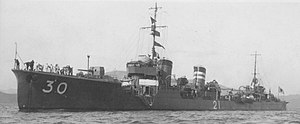Japanese destroyer Kisaragi (1925)
 Kisaragi at anchor, February 1927
| |
| History | |
|---|---|
| Name | Kisaragi |
| Namesake | February |
| Builder | Maizuru Naval Arsenal |
| Laid down | 3 June 1924 as Destroyer No. 21 |
| Launched | 5 June 1925 |
| Completed | 21 December 1925 |
| Renamed | As Kisaragi, 1 August 1928 |
| Stricken | 15 January 1942 |
| Fate | Sunk, 11 December 1941 |
| General characteristics | |
| Class and type | Mutsuki-class destroyer |
| Displacement |
|
| Length |
|
| Beam | 9.16 m (30 ft 1 in) |
| Draft | 2.96 m (9 ft 9 in) |
| Installed power |
|
| Propulsion | 2 shafts; 2 × Kampon geared steam turbines |
| Speed | 37.25 knots (68.99 km/h; 42.87 mph) |
| Range | 4,000 nmi (7,400 km; 4,600 mi) at 15 knots (28 km/h; 17 mph) |
| Complement | 150 |
| Armament |
|
| Service record | |
| Part of: | Destroyer Division 30 |
| Operations: | Battle of Wake Island |
Kisaragi (如月, "February") was one of twelve Mutsuki-class destroyers, built for the Imperial Japanese Navy (IJN) during the 1920s. Retreating after the sinking of destroyer Hayate by American coast-defense guns during the Battle of Wake Island in December 1941, Kisaragi was sunk with all hands by American aircraft. She had the distinction of being the second major Japanese warship lost during the war (after Hayate earlier the same day). She should not be confused with an earlier World War I-period Kamikaze-class destroyer with the same name.
Design and description
The Mutsuki class was an improved version of the
The main armament of the Mutsuki-class ships consisted of four
Construction and career
Kisaragi was
WWII
At the time of the
The Japanese approached the island early on the morning of 11 December, and the warships began to bombard the island at a range of 8,200 meters (9,000 yd) at 05:30. As none of the six American
Kisaragi was sailing away from the island when she was attacked and sunk by
Notes
Sources
- Chesneau, Roger, ed. (1980). Conway's All the World's Fighting Ships 1922–1946. Greenwich: Conway Maritime Press. ISBN 0-85177-146-7.
- Howarth, Stephen (1983). The Fighting Ships of the Rising Sun: The Drama of the Imperial Japanese Navy, 1895–1945. Atheneum. ISBN 0-689-11402-8.
- Jentschura, Hansgeorg; Jung, Dieter & Mickel, Peter (1977). Warships of the Imperial Japanese Navy, 1869–1945. Annapolis, Maryland: United States Naval Institute. ISBN 0-87021-893-X.
- Nevitt, Allyn D.; Tully, Anthony D. (July 2014). "IJN Kisaragi: Tabular Record of Movement". Long Lancers. Combinedfleet.com. Retrieved 10 November 2015.
- Watts, Anthony J. & Gordon, Brian G. (1971). The Imperial Japanese Navy. Garden City, New York: Doubleday. ISBN 0385012683.
- Whitley, M. J. (1988). Destroyers of World War Two. Annapolis, Maryland: Naval Institute Press. ISBN 0-87021-326-1.
- Wukovits, John (2010). Pacific Alamo: The Battle for Wake Island. NAL: Caliber. ISBN 978-1-101-65818-5.

